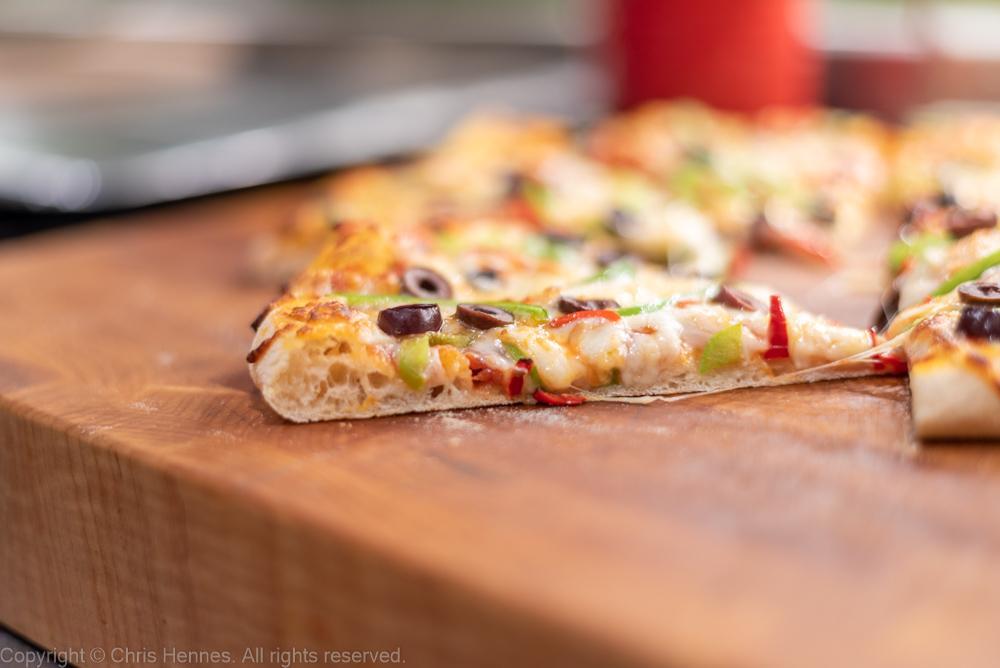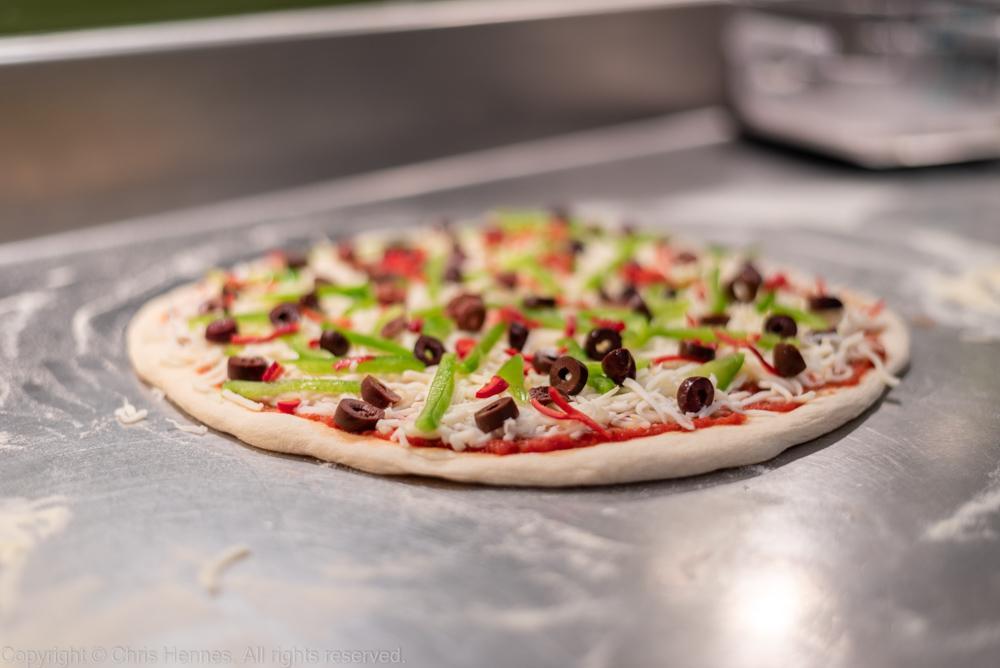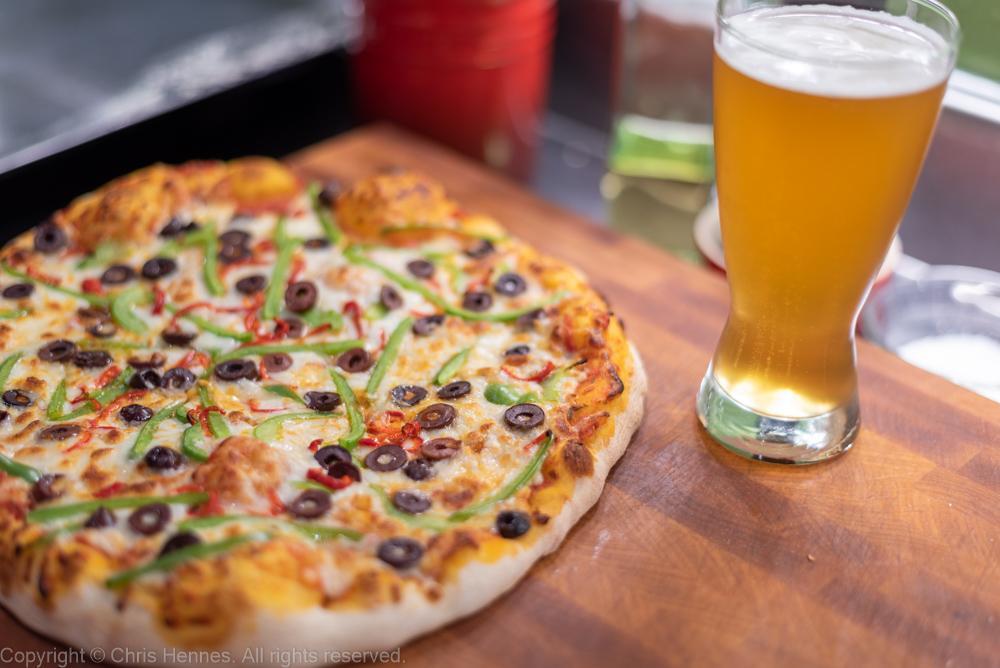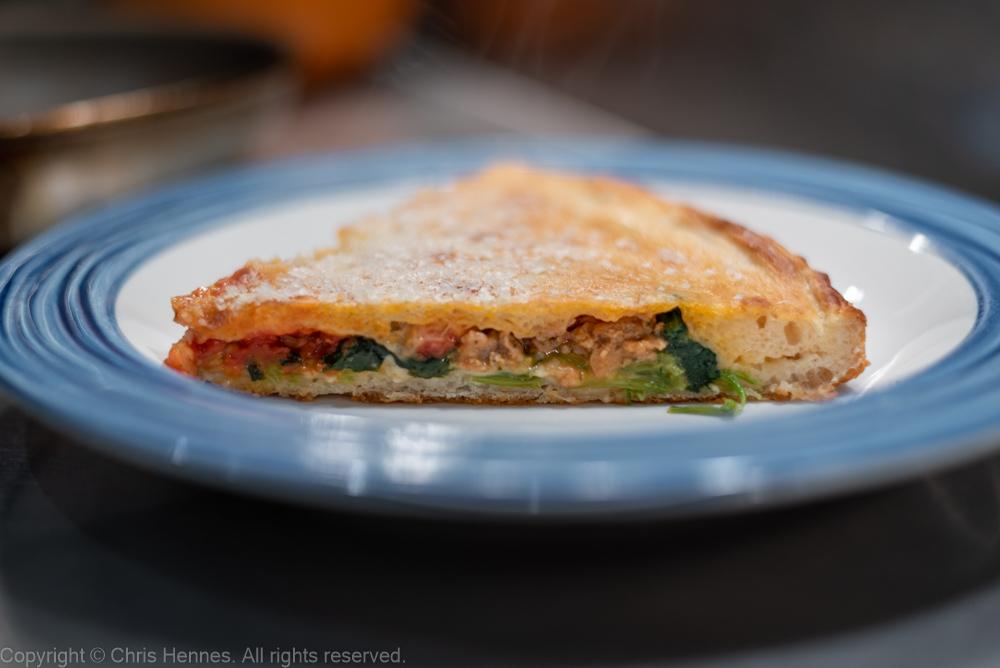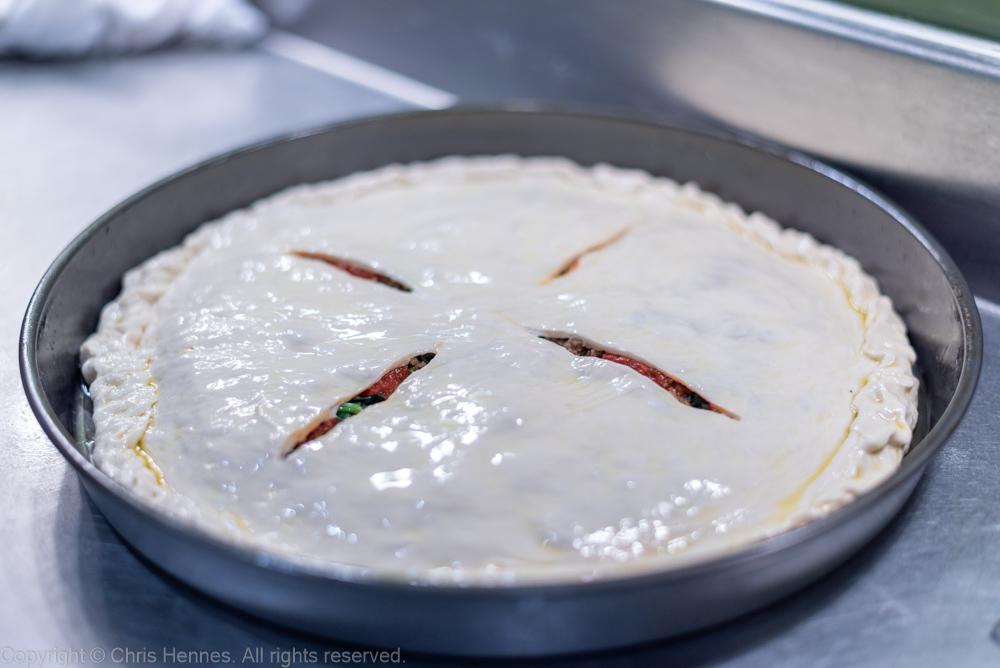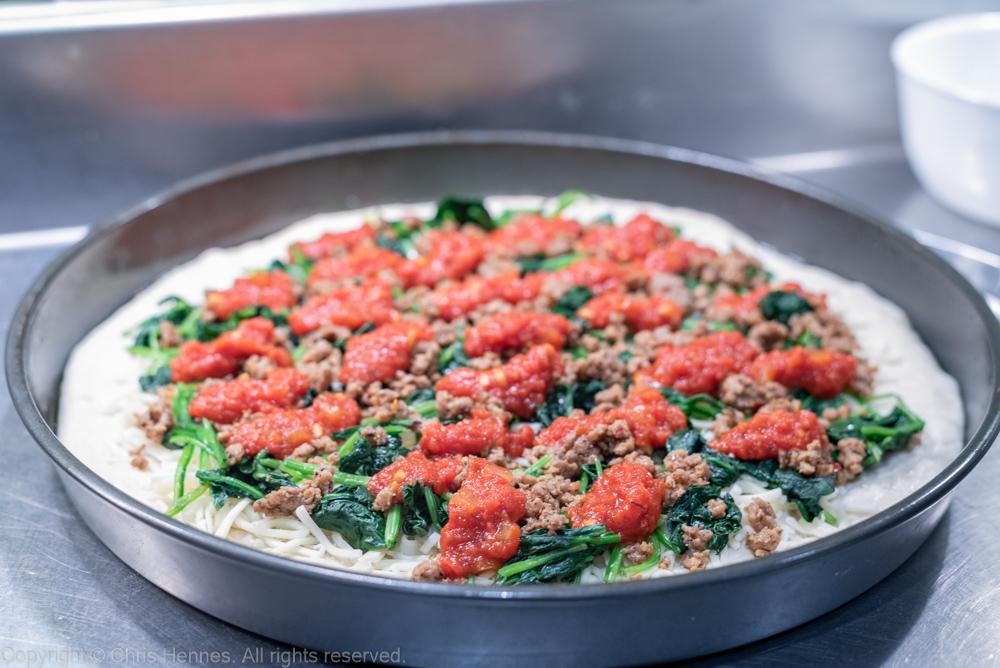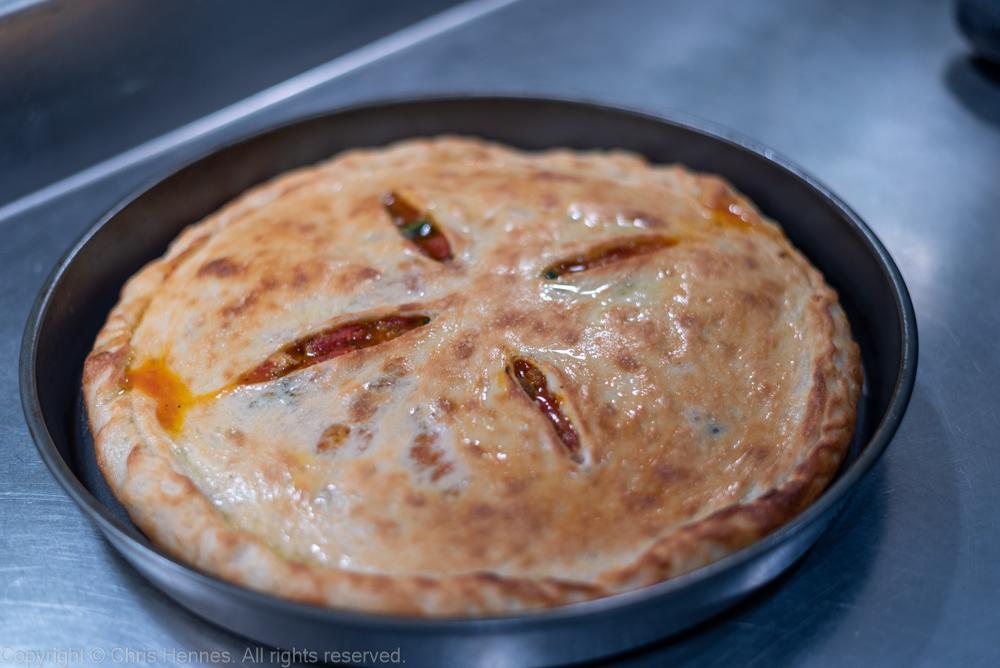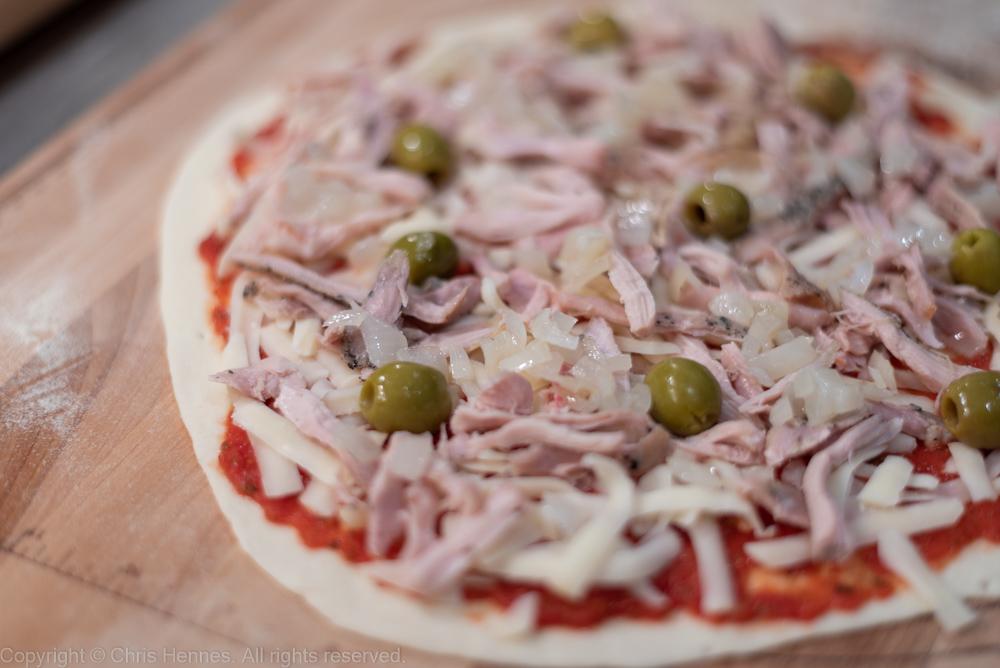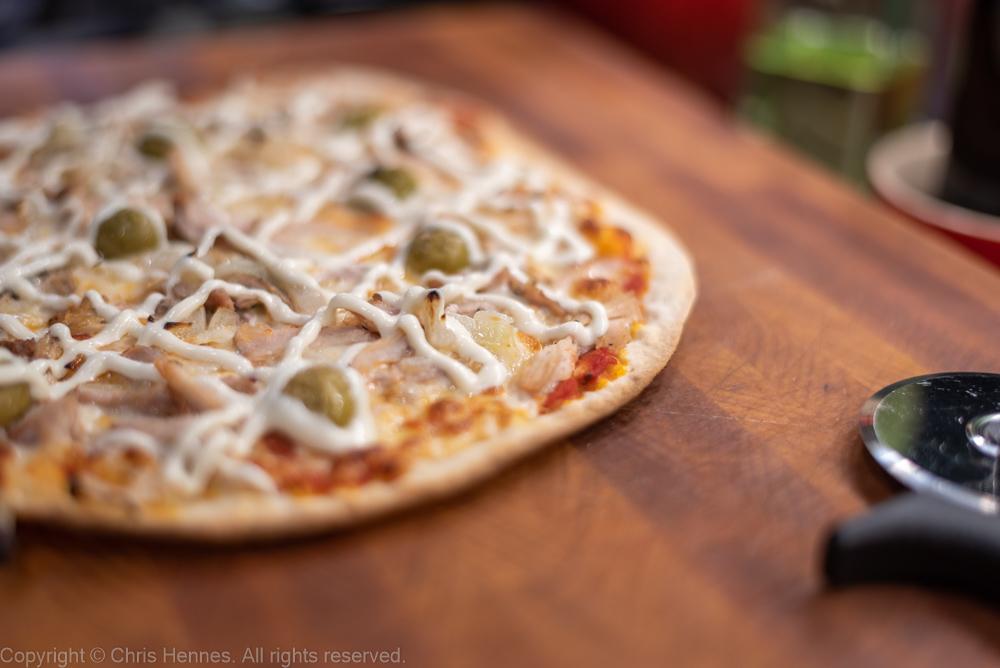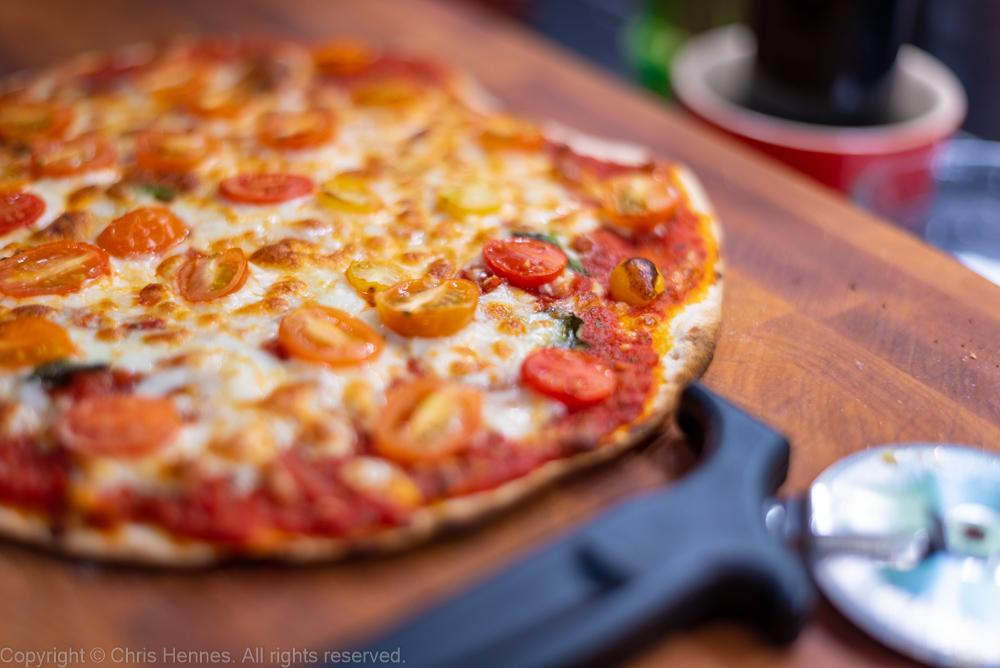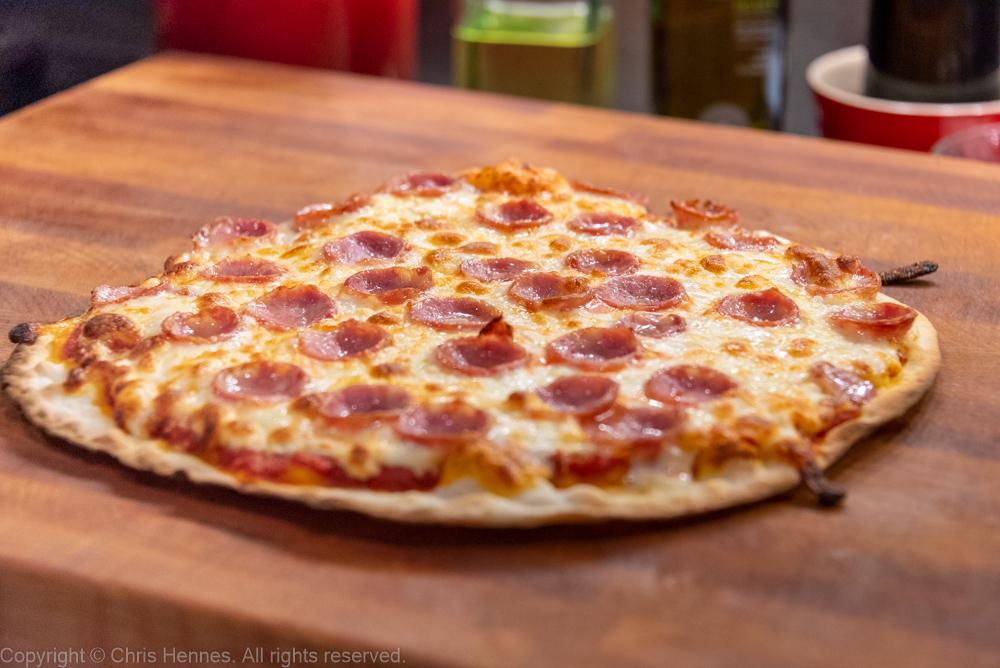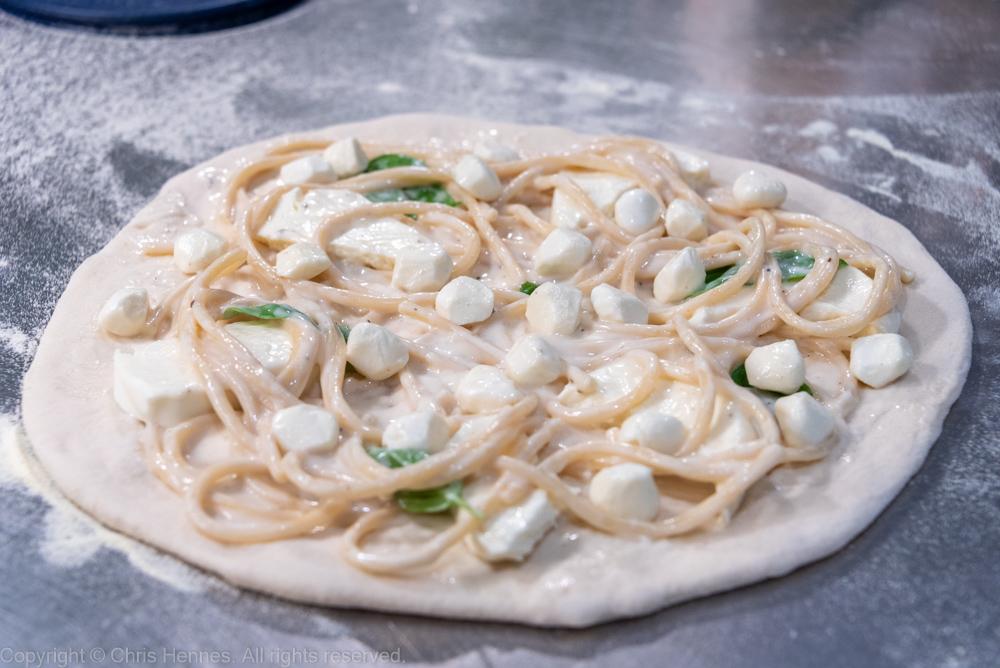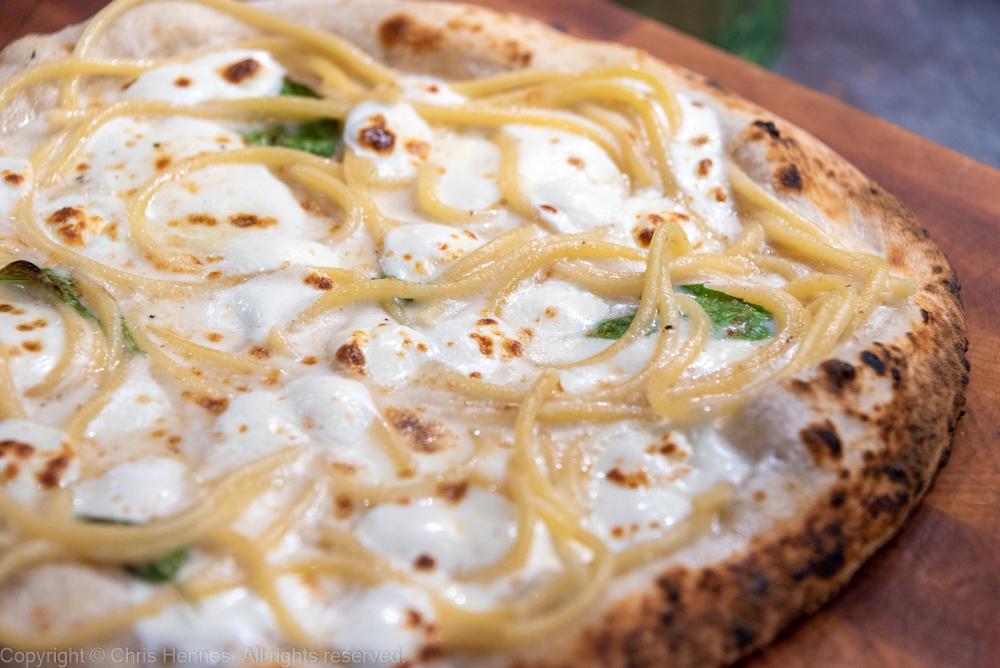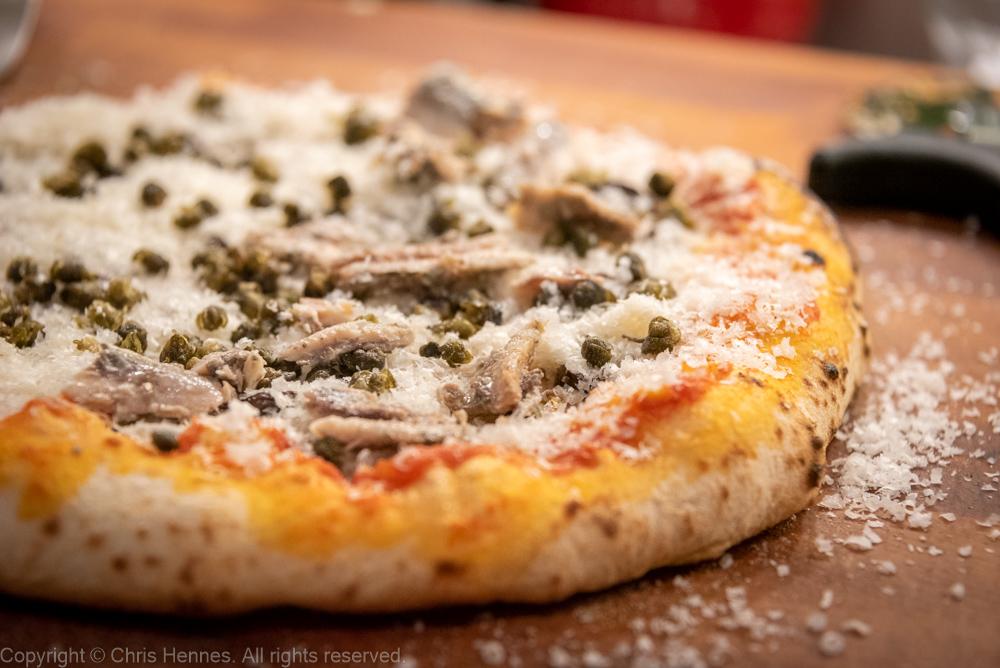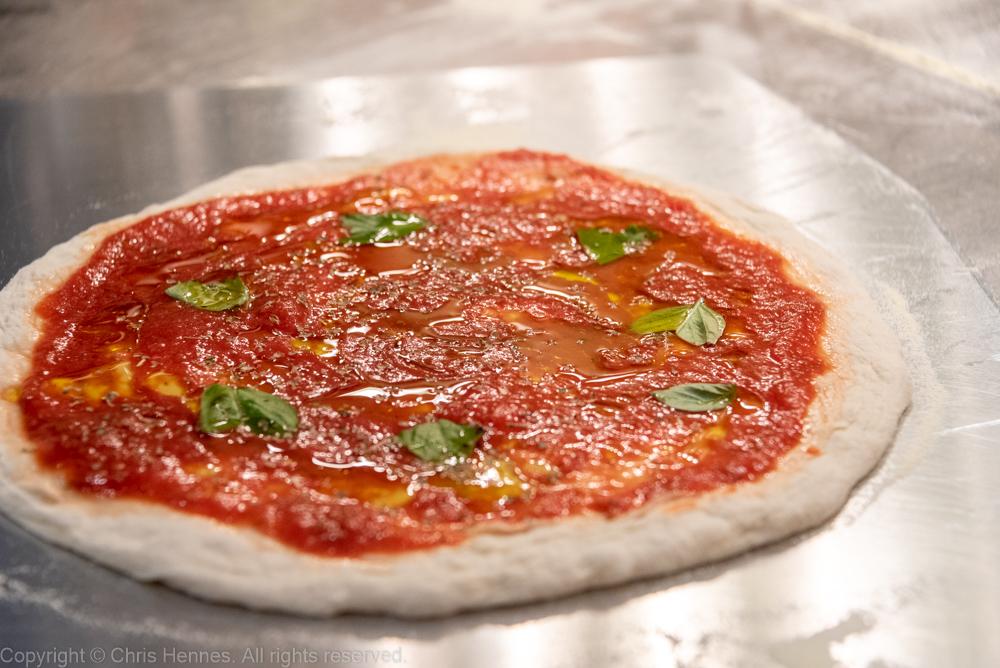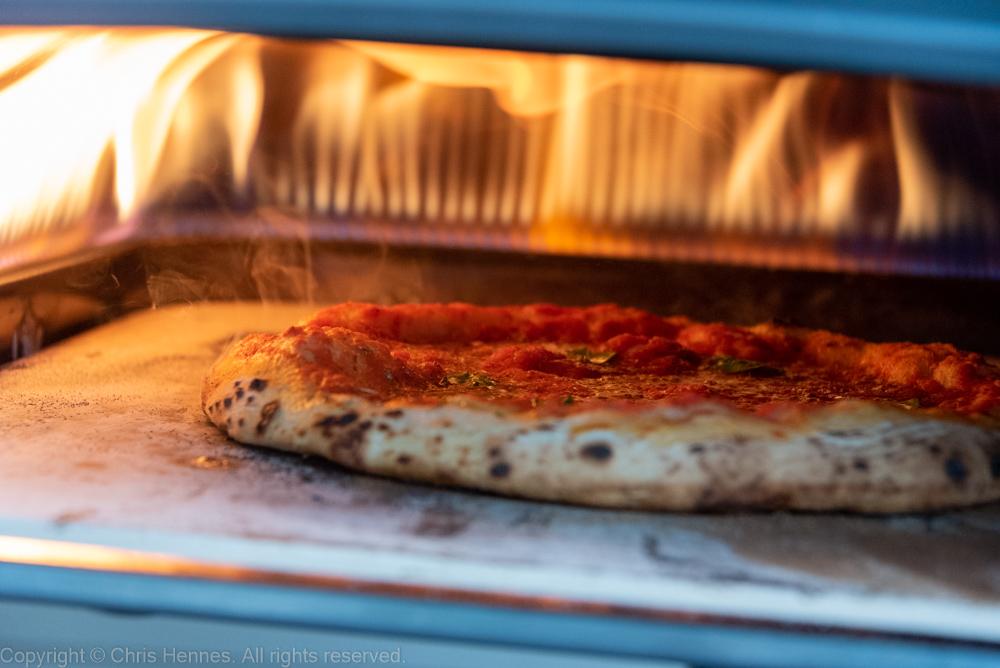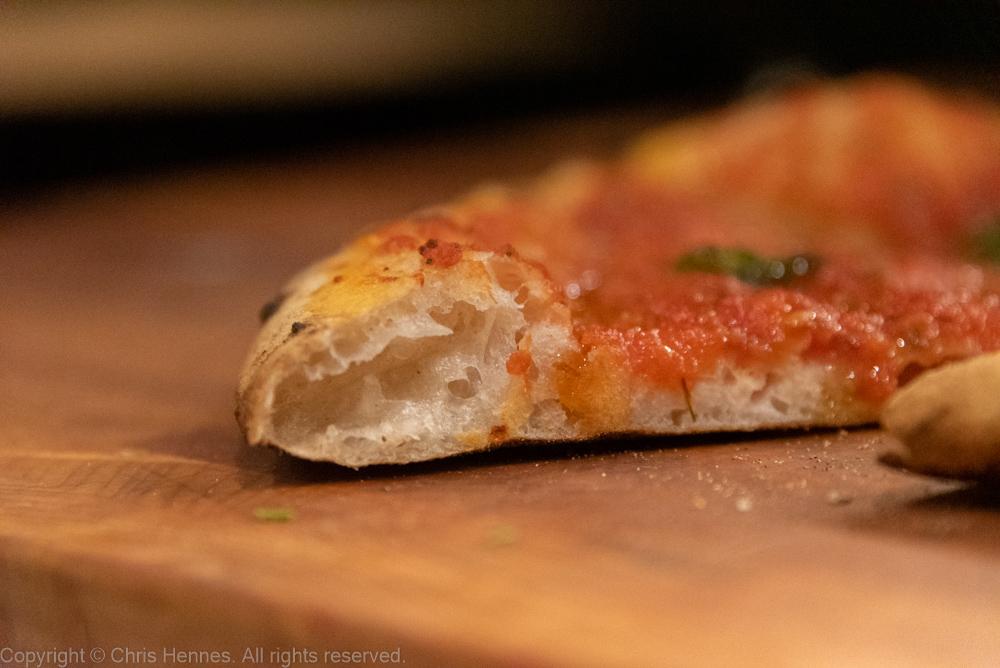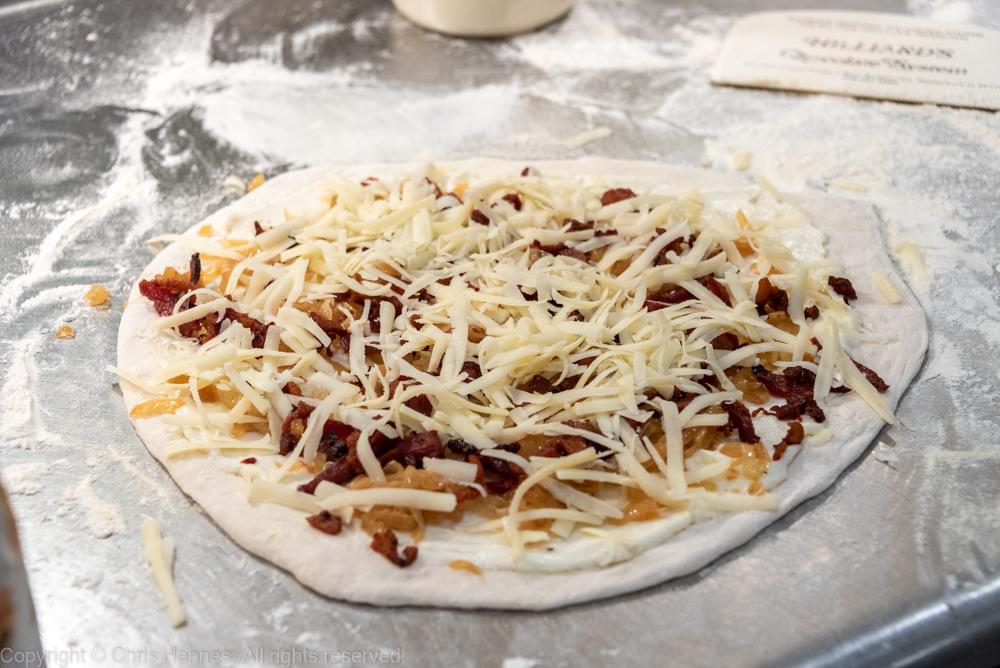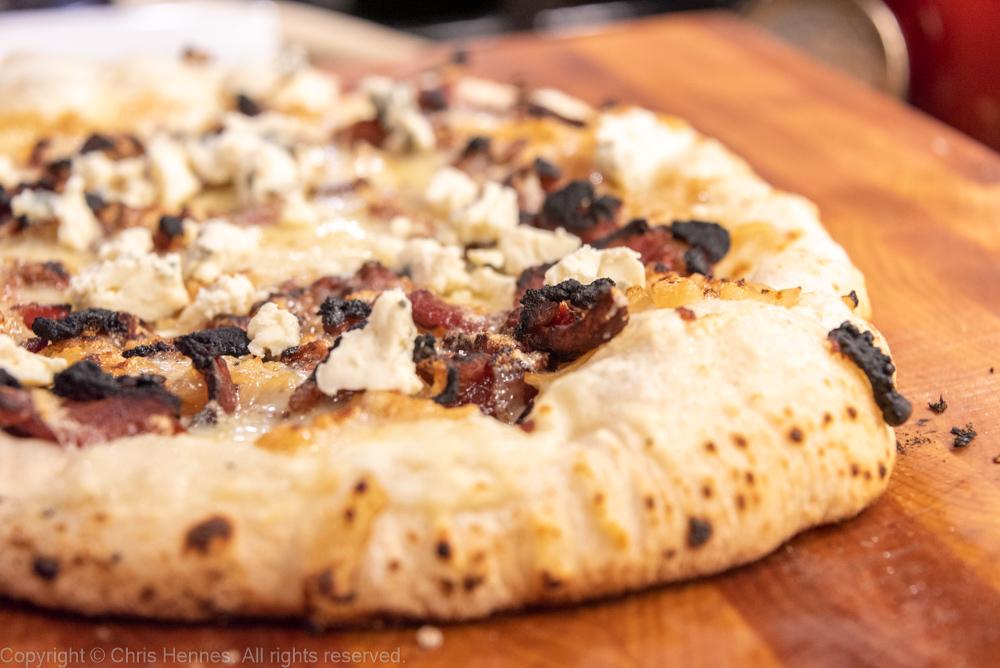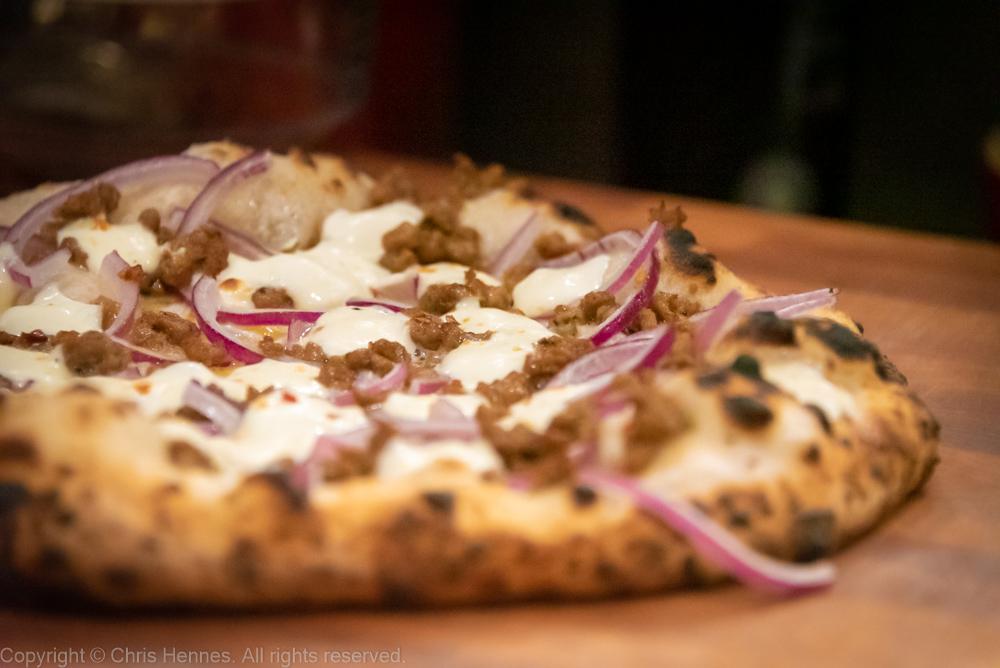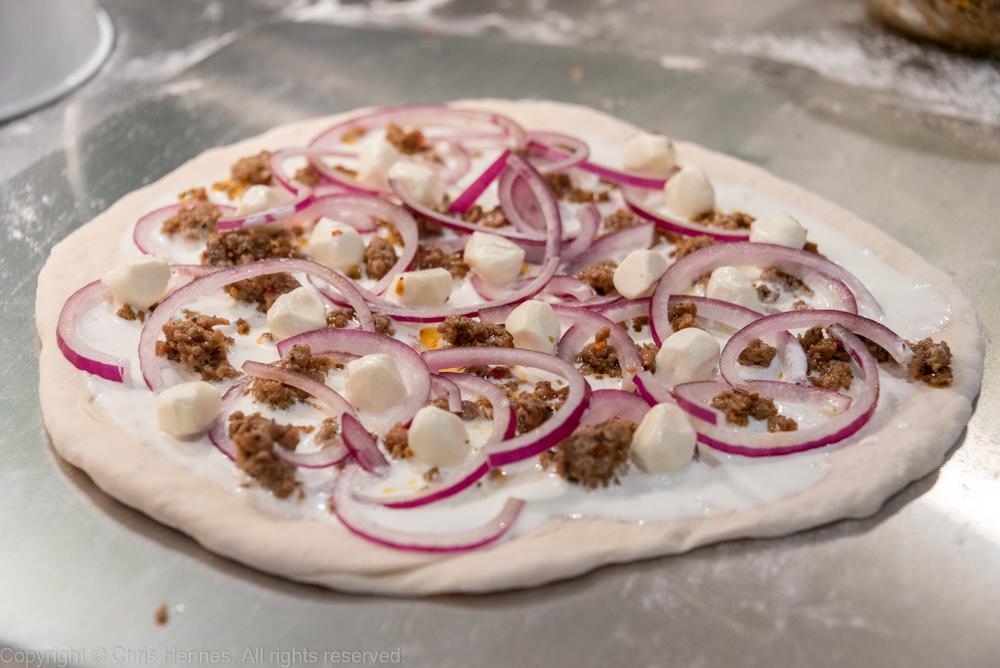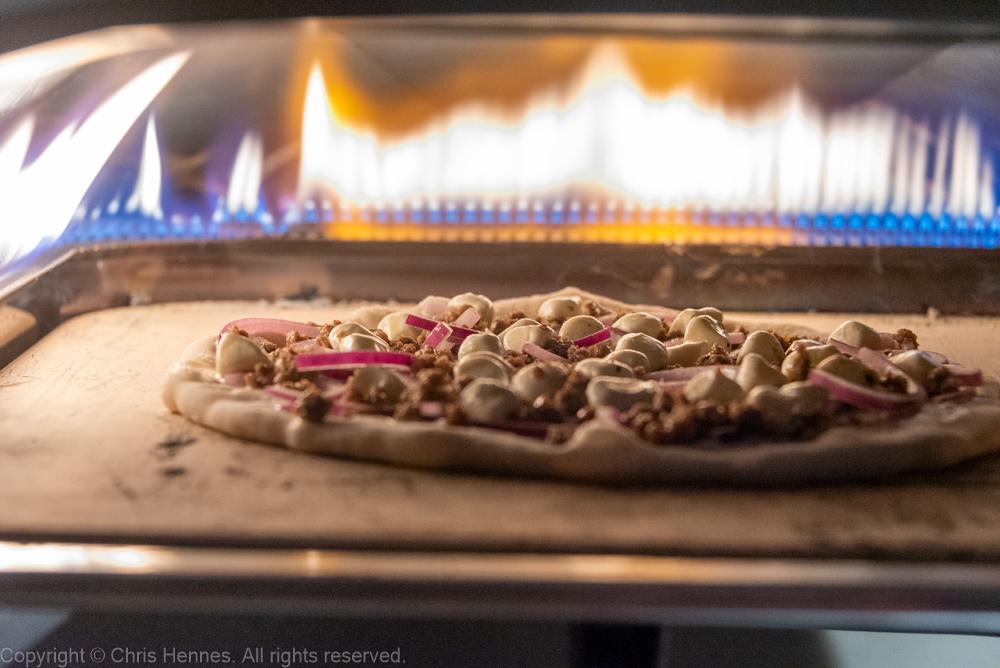-
Posts
10,190 -
Joined
-
Last visited
Content Type
Profiles
Forums
Store
Help Articles
Everything posted by Chris Hennes
-
I used a 400g dough ball because that's the size they say to use for a 14" NY pizza, and I don't know any better (yet) . I'm going to give the 400g ball another go tonight, and if it's still too much crust I'll scale back then.
-
Fortunately I have their normal dough cold-proofing right now, so it's NY pizza for at least the next two days. I'm going to get some more practice!
-
That's the technique I'm using: like I said, I'm just a coward -- I'm stopping too soon, before the dough is really as large and thin as it should be.
-
I want to spend some time this week working on New York style crusts, since my last attempt was pretty miserable. Today I made the Direct New York Pizza Dough, which is a straightforward 70% hydration dough with a 3.4% olive oil enrichment. Basically the same as their standard New York crust, but without the poolish and multi-day cold proof. Tonight's failure is more due to my cowardice than any deficiency in the crust. I am simply failing to stretch it thin enough, so the dough is overall too thick, both in the center and at the rim. It really hasn't shown any tendency to tear, but still... when you get out to window-pan-test-thickness over large sections of the interior, it's hard to keep working on the other sections! At least, it is for me. So anyway, here's take two on New York style. Better than take one, but still a ways to go... Just for @rotuts, a glass of beer with tonight's pizza (still no salad, sorry @weinoo😞 If I cherry-pick the best-looking part of the pizza, you can see that the interior crust is still quite a bit too thick: At least it still tasted good!
-
They discuss thin crust pizza (including the square cut thing, which they are not enamored with) at length: it's not identified specifically as a "Chicago" style because it's really all over the Midwest, and beyond.
-
I'd guess so: at least, Detroit is the dough I'd start with when experimenting. They mean low-moisture mozzarella -- they call it "pizza cheese" to avoid any ambiguity with fresh mozzarella. You don't have to buy it pre-shredded, though, it's sold in bricks, too. They have a page on the anti-caking agents in volume 2 page 302 -- the upshot is that cellulose works well and doesn't affecting the melting much, whereas cornstarch messes things up.
-
Our Double-Crust Pizza (KM p. 233) They do not have anything nice to say about the double-crust pizzas they ran across in their travels. It's apparently a variant on Chicago-style deep dish where there is a second crust atop the main toppings, which is then itself topped with tomato sauce. Popular at Giordano's, apparently, but suffering from exactly what's you'd expect: a gross, under-cooked, soggy top crust. Rather than just pretend it didn't exist, they riffed on it an ended up with this thing in its place. The key change is to put the tomato sauce under the top crust, rather than on top of it, and to slit the crust a few, but not too many, times. For the fillings their recipe uses sausage crumbles, spinach, pizza cheese, and their New York-style pizza sauce. So obviously it's delicious, those are all excellent, alone and together. It tastes a lot like a classic American red-sauce-joint lasagna (and I mean that in a good way). For me the big surprise here was the success of the crust(s). They use their Detroit-style crust in it -- IMO you're going to want the dough relaxer here for sure. This is rolled out to cover a 14" pizza pan, topped with the cheese, then the sausage and spinach (both cooked already), then dollops of the tomato sauce: A second, smaller crust is made the same way, layered on top, brushed with olive oil, and slit four times: Baked following the same instructions as for the normal Detroit pizza: Then sliced and served sprinkled with grated parmesan: I expected this to be a fork-and-knife experience, but actually it was completely edible sans utensils. The crust got crisp enough to hold its shape even against the fairly large filling quantity, and stayed that way long enough for us to eat the whole thing. The filling quantities they give were perfect: just barely below the "squeeze out when you bite it" stage. And brushing the top crust with olive oil and topping with grated parmesan after baking gave it a great flavor and texture. I'm sure there are some who will want to argue that this isn't pizza, but I don't really care: I'Il absolutely make it again.
- 549 replies
-
- 14
-

-

-

-
That's just gluttony! How could I eat a whole pizza and a salad?!
-
Chicken and Catupiry Brazilian Thin-Crust Pizza (KM p. 199) I've never heard of nor eaten Catupiry cheese, which is apparently a very popular brand in Brazil: Modernist Pizza says it's a "soft, spreadable cheese that we liken to a combination of mayonnaise and cream cheese. [...] we're not the biggest fans of it." And yet here's a recipe that calls for it anyway . I couldn't bring myself to buy $25 worth of cheese (eG-friendly Amazon.com link) with that kind of lukewarm endorsement. So I scrounged around the internet for substitutes, and ended up making a blend of cream cheese and brie. On its own it tasted reasonably respectable, anyway. I have no idea how close I am to the real deal. The rest of the pizza is not that crazy: shredded chicken, sweated onions, and whole green olives. I ended up cutting basically all of the quantities in half: Brazilians really seem to like their pizzas heavily topped, and I just can't bring myself to do it. Maybe if it were just the olives. But the chicken? No thanks. So anyway, here's my take on that pizza:
-
When you say "one of" though... how many are we talking? When we say there's a definable New York style, it's because there are dozens if not hundreds of places offering a stylistically similar pizza. How many places in Rome were doing that cracker crust, compared to something else (Neapolitan, New York, Focaccia with stuff on it, whatever)?
-
Brazilian Thin-Crust Margherita Pizza (KM p. 197) This is really only sort of the recipe from Modernist Pizza: they call for whole slices of beefsteak tomato, but tomato season is over here, and I had some little grape tomatoes at the end of their useful lives. So I made that substitution, and I cut the amount of cheese called for in half. So more "inspired by" Modernist Pizza and/or Brazil:
-
Their argument is that "Roman" pizza isn't a thing -- that there isn't a single definable Roman style, just a whole bunch of different styles in Rome that all say they are the true "Roman" pizza (and of course they're right, technically!). Having never been to Rome, I can't really argue the point either way. But apparently in Brazil, this is a predominant style of pizza. I can live without the crazy amount of cheese, but I definitely like the crust. We'll see about tomorrow's pizza, it's another sort of strange one.
-
Brazilian Thin-Crust Calabresa Pizza (KM p. 195) Apparently one of the defining characteristics of Brazilian pizza is that they put a lot of cheese on them. In this case, 190g of pizza cheese for a 12" pizza. Not my favorite, to be honest. On the plus side, though, the super-thin cracker-like crust turned out well, I liked that quite a lot! And I'd never had Brazilian Calabresa sausage (it's not at all like the Italian Calabrese) -- it wasn't bad. Pretty plain, but overall fine as a pizza topping.
-
Do you mean the one with the ice? I've tried it, it did not go well for me! Have you had better results?
-
Cacio e Pepe Pizza (KM p. 304) @weinoo avert your eyes! I've posted several times before about my attempts to make a cacio e pepe pizza (here and here) -- the Modernist Pizza variant takes a tack that would never have occurred to me. You basically just put spaghetti cacio e pepe on a pizza. Right... including the spaghetti. This is an assembly recipe from their "Flavor Themes" section, based on a Neapolitan crust. The recipe has you make a cacio e pepe sauce using Wondra and xanthan gum as the starch/thickening component (since you are making it independent of the pasta, I guess). To top the pizza, you put down some large slices of fresh mozzarella, make spaghetti (I actually used bucatini, I had a fraction of a box to use up), add the premade sauce and some cream to the spaghetti and spread it out over the pizza, tuck some basil (?!?) leaves into it, and put some small mozzarella balls on top. It ends up being a lot of cheese! I suppose that's appropriate for cacio e pepe. Actually, it could have used more "pepe"! All told, it wasn't bad pizza, but I'm not really sure there was much payoff to putting the actual pasta on there besides the "wow that's weird" factor. I found the basil to be a bit incongruous, so I left it off the second pizza and added more pepper, which I preferred.
- 549 replies
-
- 10
-

-

-
Pizza Puttanesca (KM p. 274) Sort of an obvious one, from their "Inspired by Italian Ingredients or Dishes" table. I mean, I've certainly made many pizzas with olives and capers as a topping, so it's not a great leap to actually make a puttanesca sauce and use it as pizza sauce. Here the toppings are black olives added pre-baking, and Parmigiano, fried capers, and anchovies added after. (The cheese can be put on before or after baking, so I tried one of each - I preferred the "after" option). Delicious, of course! Served on their original Neapolitan, with the dough relaxer (I'm getting better with the peel, this is not such an ordeal as the first time I tried).
-
It seems like more work than it is -- there's still no cooking involved, so it only takes a couple of minutes, and really only the first time you make it. After that you know what texture they are going for and you don't really have to micromanage (at least, I don't).
-
Tokyo Marinara Pizza (KM p. 208) I made this again with the high-hydration dough I used yesterday: this time it was double-aged, this was the same batch of dough. Apparently the defining characteristic of Tokyo Marinara is an enormous amount of olive oil drizzled over the pizza before baking. It's also got a bit of torn basil and dried oregano that the original lacks. And yes, it's supposed to have garlic... which is still sitting on my counter, I think, I completely spaced on adding it I was in such a hurry to prevent the dough from sticking. Doh! That's about 2 tablespoons of olive oil on that 12" pizza: it's a lot. It's a bit "flamey" in the oven, but I didn't get a shot of any of the more exciting conflagration, there's not a lot of downtime for photography while making these! The crust comes out nicely, with good pillowy edges, but truth be told I'm not sure it's really much of an improvement over their normal Neapolitan dough, which is certainly easier to work with. Maybe in a few hundred pizzas I'll have a clearer sense of it.
-
Well, at any rate, the olive oil won't affect the thickening of the xanthan gum, so you are free to add it.
-
You might try Twitter or Instagram, they're pretty active on social media.
-
For a batch this size (1kg), I use a 2qt cambro (the short and wide one, not the tall skinny one). The dough puffs up pretty close to the top, but not over it.
-
Yeah, it's something they wrote about in Modernist Bread -- what you're really trying to do is hydrate the flour, that's what's causing the gluten formation, not the mechanical mixing action. You can basically instantly hydrate it by putting it in a chamber vacuum and running a cycle. With a dough like this one, it's hard to get the mixer to grab it, even running at 100% speed, so I don't bother. Get it mixed, and then into the chamber.
-
I just followed the recipe exactly, I didn't worry about whether I actually got every gram: that's been my process with all this sort of recipe in Modernist Bread as well. I very rarely try to get full gluten formation with my mixer: I let it do the preliminary mix and go for a few minutes, then switch to using the vacuum chamber to finish it off. Feels like cheating, but the dough is perfect every time.
-
Bacon and Onion Pizza (KM p.273) with Modernist High-Hydration Neapolitan Dough (KM p. 40) Up to now I've been making my Neapolitan pizzas with their standard Neapolitan dough recipe. Tonight I tried the Modernist variant, which makes a 82% hydration dough by pregelatinizing some of the flour -- this is the dough that @Robenco15 has been posting about up-topic. I used the Caputo 00 "Chef's Flour", same as I've been using for all my Neapolitans. I have one more 1kg bag of it left before I'm switching to their Pizzeria flour. Even with the Modernist treatment the dough basically behaves like a 82% hydration dough (surprise!!), so on the one hand it practically shapes itself, but on the other it is very sticky, and sucks up the flour you put down to lubricate your peel very quickly. Very, very, VERY quickly. I was apparently too lackadaisical in strolling to my pizza oven the first time, the pizza simply would not come off the peel: it was a total loss, it sort of rolled into a slopped mess in the oven, and from there went straight into the trash bin. The second time I put a bit more zip in my step (and used semolina) and managed to get the pizza into the oven with a very vigorous shake of the peel. So I at least got one pizza tonight. Sort of. I was making a pizza from their "Classic" ingredients table. It's got a bechamel sauce, swiss cheese, bacon lardons, browned onions, and crumbled gorgonzola (added after baking). For the bechamel I tried the "Modernist" variant in this book, which is different from the one in Modernist Cuisine and Modernist Bread: in this case it's really just a milk fluid gel. It works fine as a pizza topping, but tasted on its own I think I prefer the original version they developed, with the pressure-cooked roux. Then, I missed what turned out to be a critical note about the bacon lardons, unfortunately. It says "partially rendered". I'm not used to cooking at this temperature, I just made the bacon the way I normally do for pizza. So it burned in the oven. Doh! I remind myself that I bought the books specifically to push my cooking skills... it's working! Two more "learning experiences" tonight!
-
Sausage and Cream Pizza (KM p. 277) From the "tables of toppings" section labeled "Inspired by Pizzerias/Pizzaioli" comes this pizza that was "inspired by" Nancy Silverton. I used the standard Neapolitan crust, baked in the Ooni at full temp. The sauce is just heavy cream: for my first pizza I used the "standard" sauce amount of 120g, which seemed plausible when the cream was at room temperature. AHAHAHAHA😆. No. When I cut the pizza after baking all the cream just ran off onto the cutting board. So for pizza two I lightly coated the dough with the cream, probably more like 40-50g: this was much more successful. I love that the red onions stay crisp on this pizza, overall the flavors were great, but truthfully I'd probably prefer a more standard bechamel sauce here, or potentially just a layer of crème fraîche. Would I then have a pizza "inspired by Modernist Pizza which was inspired by Nancy Silverton"? Here's what that first pie looked like pre-bake Can't get enough of these oven shots, I love the color of the backlit onions... This is the second pizza: you can't really tell, but it is not a bowl of sausage and cream soup:
- 549 replies
-
- 10
-

-




